New Page 3
(From Home Page)
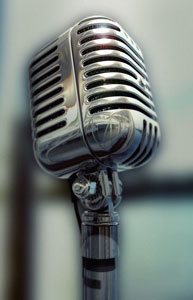 It was not until after the Titanic catastrophe
in 1912 that radio for mass communication came
into vogue, inspired first by the work of
amateur (or "ham") radio operators. Radio was
especially important during World War I as it
was vital for air and naval operations. World
War I brought about major developments in radio,
superseding the Morse code of the wireless
telegraph with the vocal communication of the
wireless telephone, through advancements in
vacuum tube technology and the introduction of
the transceiver.
It was not until after the Titanic catastrophe
in 1912 that radio for mass communication came
into vogue, inspired first by the work of
amateur (or "ham") radio operators. Radio was
especially important during World War I as it
was vital for air and naval operations. World
War I brought about major developments in radio,
superseding the Morse code of the wireless
telegraph with the vocal communication of the
wireless telephone, through advancements in
vacuum tube technology and the introduction of
the transceiver.
After the war, numerous radio stations were born
in the United States and set the standard for
later radio programs. The first radio news
program was broadcast on August 31, 1920 on the
station 8MK in Detroit, Michigan; owned by the
Detroit News, the station covered local election
results. This was followed in 1920 with the
first commercial radio station in the United
States, KDKA, being established in Pittsburgh,
Pennsylvania. The first regular entertainment
programs were broadcast in 1922, and on March
10, Variety carried the front page headline:
"Radio Sweeping Country: 1,000,000 Sets in
Use."[4] A highlight of this time was the first
Rose Bowl being broadcast on January 1, 1923 on
the Los Angeles station KHJ
Types of programs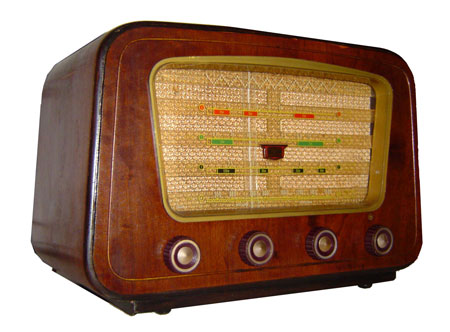
During the Golden Age of Radio,
radio featured genres and formats popular in other forms of American
entertainment—adventure, comedy, drama, horror, mystery, musical variety,
romance, thrillers—along with classical music concerts,
big band remotes, farm
reports, news and commentary, panel discussions, quiz shows (beginning with
Professor Quiz),
sidewalk interviews (on
Vox Pop), broadcasts,
talent shows and weather forecasts.
In
the late 1920s, the sponsored musical feature was the most popular program
format. Commercial messages were regarded as intrusive, so these shows usually
displayed the sponsor's name in the title, as evidenced by such programs as
The A&P Gypsies,
Acousticon Hour,
Champion Spark Plug Hour,
The Clicquot Club Eskimos,
The Flit Soldiers, The Fox Fur Trappers, The Goodrich Zippers,
The Ingram Shavers,
The Ipana Troubadors,
The Planters Pickers, The Silvertown Cord Orchestra (featuring the
Silver Masked Tenor), The Sylvania Foresters, The Yeast Foamers,
King Biscuit Time
(with
Sonny Boy Williamson),
The Health and Happiness Radio Show (with
Hank Williams)and the
Light Crust Doughboys (with
Bob Wills and
Milton Brown). During the
1930s and 1940s, the leading orchestras were heard often through big band
remotes, and NBC's
Monitor continued
such remotes well in the 1950s by broadcasting live music from New York City
jazz clubs to rural America.
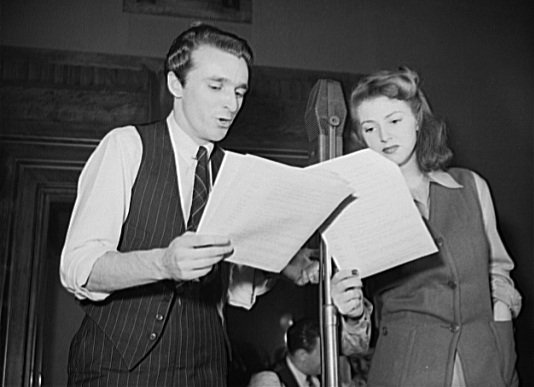 Classical music programs
on the air included
The Voice of Firestone
and
The Bell Telephone Hour.
Texaco sponsored the
Metropolitan Opera radio broadcasts;
the broadcasts, now sponsored by the
Toll Brothers, continue
to this day around the world, and are one of the few examples of live classical
music still broadcast on radio. One of the most notable of all classical music
radio programs of the Golden Age of Radio featured the celebrated Italian
conductor
Arturo Toscanini
conducting the
NBC Symphony Orchestra,
which had been created especially for him. At that time, nearly all classical
musicians and critics considered Toscanini the greatest living maestro. There
were also popular songwriters featured on radio, such as
George Gershwin, who in
addition to appearing as a guest, also had his own program in 1934.
Classical music programs
on the air included
The Voice of Firestone
and
The Bell Telephone Hour.
Texaco sponsored the
Metropolitan Opera radio broadcasts;
the broadcasts, now sponsored by the
Toll Brothers, continue
to this day around the world, and are one of the few examples of live classical
music still broadcast on radio. One of the most notable of all classical music
radio programs of the Golden Age of Radio featured the celebrated Italian
conductor
Arturo Toscanini
conducting the
NBC Symphony Orchestra,
which had been created especially for him. At that time, nearly all classical
musicians and critics considered Toscanini the greatest living maestro. There
were also popular songwriters featured on radio, such as
George Gershwin, who in
addition to appearing as a guest, also had his own program in 1934.
Country music also
enjoyed popularity.
National Barn Dance,
begun on Chicago's
WLS-AM in 1924, was
picked up by
NBC Radio in 1933. In
1925,
WSM Barn Dance
went on the air from
Nashville. It was renamed
the
Grand Ole Opry in
1927 and NBC carried portions from 1944 to 1956. NBC also aired
The
Red Foley Show
from 1951–1961, and
ABC Radio carried
Ozark Jubilee from
1953 to 1961.
Top comedy talents surfed the
airwaves for many years:
Fred Allen,
Jack Benny,
Victor Borge,
Fanny Brice,
Billie Burke,
Bob Burns,
Judy Canova,
Jimmy Durante,
Phil Harris,
Bob Hope,
Groucho Marx,
Jean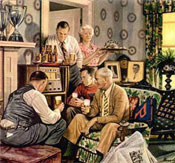 Shepherd,
Red Skelton and
Ed Wynn. More laughter
was generated on such shows as
Abbott and Costello,
Amos 'n' Andy,
Burns and Allen,
Easy Aces,
Ethel and Albert,
Fibber McGee and Molly,
The Goldbergs,
The Great Gildersleeve,
The Halls of Ivy
(which featured screen star
Ronald Colman and his
wife
Benita Hume),
Meet Corliss Archer,
Meet Millie, and
Our Miss Brooks.
Shepherd,
Red Skelton and
Ed Wynn. More laughter
was generated on such shows as
Abbott and Costello,
Amos 'n' Andy,
Burns and Allen,
Easy Aces,
Ethel and Albert,
Fibber McGee and Molly,
The Goldbergs,
The Great Gildersleeve,
The Halls of Ivy
(which featured screen star
Ronald Colman and his
wife
Benita Hume),
Meet Corliss Archer,
Meet Millie, and
Our Miss Brooks.
Radio comedy ran the gamut from the
small town humor of
Lum and Abner,
Herb Shriner and
Minnie Pearl to the
dialect characterizations of
Mel Blanc and the caustic
sarcasm of
Henry Morgan. Gags galore
were delivered weekly on
Stop Me If You've Heard This One
and
Can You Top This?,
[1] panel programs
devoted to the art of telling jokes. Quiz shows were lampooned on
It Pays to Be Ignorant,
and other memorable parodies were presented by such satirists as
Spike Jones,
Stoopnagle and Budd,
Stan Freberg and
Bob and Ray. British
comedy reached American shores in a major assault when NBC carried
The Goon Show in the
mid-1950s.
Some shows originated as stage
productions: Clifford Goldsmith's play What a Life was reworked into
NBC's popular, long-run
The Aldrich Family
(1939–1953) with the familiar
catchphrases "Henry!
Henry Aldrich!," followed by Henry's answer, "Coming, Mother!" Moss Hart and
George S. Kaufman's Pulitzer Prize-winning Broadway hit,
You Can't Take It with You
(1936), became a weekly situation comedy heard on Mutual (1944) with Everett
Sloane and later on NBC (1951) with
Walter Brennan.
Other shows were adapted from comic
strips, such as
Blondie,
Dick Tracy,
Gasoline Alley,
The Gumps,
Li'l Abner,
Little Orphan Annie,
Popeye the Sailor,
Red Ryder,
Reg'lar Fellers,
Terry and the Pirates
and
Tillie the Toiler.
Bob Montana's redheaded teen of comic strips and comic books was heard on
radio's
Archie Andrews from
1943 to 1953. The Timid Soul was a 1941–1942 comedy based on cartoonist
H. T. Webster's famed
Casper Milquetoast
character, and Robert L. Ripley's
Believe It or Not! was
adapted to several different radio formats during the 1930s and 1940s.
The first
soap opera,
Clara, Lu, and Em was
introduced in 1930 on Chicago's
WGN-AM. When daytime
serials began in the early 1930s, they became known as soap operas because many
were sponsored by soap products and detergents. The line-up of late afternoon
adventure serials included Bobby Benson and the B-Bar-B Riders,
The Cisco Kid,
Jack Armstrong, the All-American Boy,
Captain Midnight, and
The Tom Mix Ralston Straight Shooters.
Badges, rings, decoding devices and other
radio premiums offered on
these adventure shows were often allied with a sponsor's product, requiring the
young listeners to mail in a box top from a breakfast cereal or other
proof of purchase.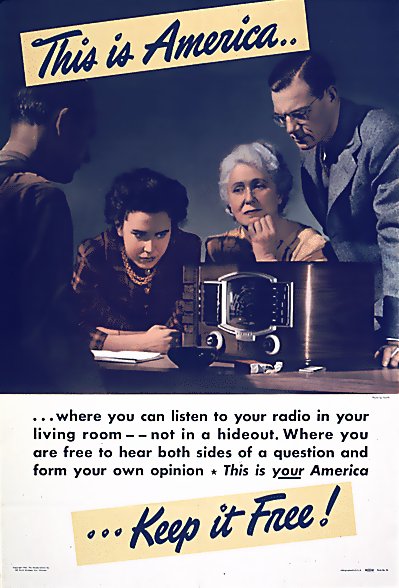
Outstanding radio dramas were
presented on such programs as
26 by Corwin, NBC
Short Story,
Arch Oboler's Plays,
Quiet, Please, and
CBS Radio Workshop.
Orson Welles's
Mercury Theatre on the Air
and
Campbell Playhouse
were considered by many critics to be the finest radio drama anthologies ever
presented. They usually starred Welles in the leading role, along with celebrity
guest stars such as
Margaret Sullavan or
Helen Hayes, in
adaptations from literature, Broadway, and/or films. They included such titles
as
Liliom,
Oliver Twist (a title
now feared lost),
A Tale of Two Cities,
Lost Horizon, and
The Murder of Roger Ackroyd.
It was on Mercury Theatre that Welles presented his
celebrated-but-infamous adaptation of
H.G. Wells's
The War of the Worlds,
formatted to sound like a
breaking news program.
Theatre Guild on the Air
presented adaptations of classical and Broadway plays. Their Shakespeare
adaptations included a one-hour
Macbeth starring
Maurice Evans and
Judith Anderson, and a
ninety-minute
Hamlet, starring
John Gielgud.[5]
Many of these programs still survive.
During the 1940s,
Basil Rathbone and
Nigel Bruce, famous for
playing
Sherlock Holmes and
Dr. Watson in films,
repeated their characterizations on radio in both original stories and in
episodes directly adapted from
Arthur Conan Doyle's
stories. None of the episodes in which Rathbone and Bruce starred in on the
radio program were filmed with the two actors as Holmes and Watson, so radio
became the only medium in which audiences were able to experience Rathbone and
Bruce appearing in some of the more famous Holmes stories, such as "The
Speckled Band". There were also several
dramatizations of Sherlock Holmes stories on radio without Rathbone and Bruce.
During the latter part of his
career, celebrated actor
John Barrymore starred in
a radio program, Streamlined Shakespeare, which featured him in a series
of one-hour adaptations of
Shakespeare plays, many
of which Barrymore never appeared in either on stage or in films, such as
Twelfth Night (in
which he played both
Malvolio and
Sir Toby Belch), and
Macbeth.
Lux Radio Theater and
The Screen Guild Theater
presented adaptations of Hollywood movies, performed before a live audience,
usually with cast members from the original films.
Suspense,
Escape,
The Mysterious Traveler
and
Inner Sanctum Mysteries
were popular thriller anthology series. Leading writers who created original
material for radio included
Norman Corwin,
Carlton E. Morse,
David Goodis,
Archibald MacLeish,
Arthur Miller,
Arch Oboler,
Wyllis Cooper,
Rod Serling,
Jay Bennett, and
Irwin Shaw.
History of professional radio recordings in the United States
Radio stations
In the beginning of the Golden Age,
American
radio network programs
were presented almost exclusively live, as the national networks prohibited the
airing of recorded programs until the late 1940s, due to the poor audio quality
of programs broadcast from the early shellac or acetate grammophone discs, which
were the only practical recording medium. As a result, prime-time shows would be
performed twice, once for each coast. However, some programs were recorded as
they were being broadcast, for
syndication or for
advertisers to have their own copy. When the networks became more open to airing
recorded programs, in the 1950s, recordings became more common.
The RCA 44BX microphone had two live faces
and two dead ones. Thus actors could face each other and react. An actor could
give the effect of leaving the room by simply moving his head toward the dead
face of the microphone. The scripts were paperclipped together, and pages were
dropped to the carpeted floor after use. Sometimes when reassembling a script to
use it for the next time zone, some pages would be out of order or missing
entirely.
Recording was done using a cutting
lathe and
acetate discs. Typically,
the track started at the inside of the disc and ran to the outside, as the spoil
from the cutting head had to be kept out of the cutting head's path. It was
easiest to use a brush and pile it up in the middle. Some lathes used a vacuum
to pick up the spoil as it was cut from the surface of the blank disc. The
vacuum came from a water aspirator. Programs were cut using 16 inch discs, which
was the most common disc size for transcriptions.
Recordings of radio programs were
typically made at a
radio network's studios,
since the expense and expertise of making a recording was usually more than a
local station was capable of handling. Recordings required special equipment and
trained technicians who had to monitor the recording while it was being made.
Hence a network-owned station might have four or more lathes, whereas a local
station often had none. However, there are some
surviving recordings
produced by
affiliate stations.[6]
Armed Forces Radio
Service
The Armed Forces Radio Service (AFRS)
had its origins in the U.S.
War Department's quest to
improve troop morale. This quest began with short-wave broadcasts of educational
and information programs to troops in 1940. In 1941, the War Department began
issuing "Buddy Kits" (B-Kits) to departing troops, which comprised radios, 78
RPM shellac records, and electrical transcription disks of radio shows. However,
with the entrance of the United States into World War II, the War Department
decided that it needed to improve the quality and quantity of its offerings.
This began with the broadcasting of its
own original variety programs. Command Performance was the first of
these, produced for the first time on March 1, 1942. On May 26, 1942, the Armed
Forces Radio Service was formally established. Originally, its programming
comprised network radio shows with the commercials removed. However, it soon
began producing original programming, such as Mail Call, G.I. Journal,
Jubilee and G.I. Jive. At its peak in 1945, the Service produced
around 20 hours of original programming each week.
After the war, the AFRS continued
providing programming to troops in Europe. In addition, it also provided
programming for future wars that the United States was involved in. It survives
today as a component of the
American Forces Network (AFN).
All of the shows aired by the AFRS
during the Golden Age were recorded onto electrical transcription disks and
shipped to stations, to be broadcast to troops overseas. People in the United
States rarely ever heard programming from the AFRS,[7]
though AFRS recordings of Golden Age network shows were occasionally broadcast
on some domestic stations beginning in the 1950s.
Home
radio recordings in the United States
There was some home recording of radio in
the 1930s and early 1940s. Home recording at that time could typically only be
performed by home disk recorders, which were only capable of storing five
minutes of a radio program per side on a seven-inch record. As a result of the
short durations of these records and the expense of the recorders, home
recording was uncommon during this period.
The lack of suitable home recording
equipment was somewhat relieved in 1947 with the introduction of home tape
recorders using
Scotch 100 tape.[8]
However, the quality of recordings made from these devices was far below
professional levels. In fact, home recording of radio programs did not become
common until around 1950, when affordable reel-to-reel tape recorders were
introduced to the market.[9]
Recording media
Electrical
transcription disks
When radio stations first began
recording programs, they recorded onto
records called
"electrical transcription" (ET) disks. Originally, these disks varied in both
size and composition, although they were typically bare aluminium. By the
mid-1930s, 16-inch aluminium-based disks coated with cellulose nitrate lacquer,
known as
acetates, recorded at a
speed of 33 1/3
RPM, became the standard
(invented in 1932 by RCA Victor). These disks were recorded using the "hill and
dale" process, in contrast to the side-to-side recording method used by
commercial recording studios. Disks could store fifteen minutes of a show on
each side, allowing a 30-minute program to be stored on one side of two separate
disks. The disks deteriorated rapidly on each playing, allowing only a few
playbacks before being destroyed.
During World War II, aluminium
became a necessary material for the war effort. This caused alternatives to be
used for electrical transcription disks, as aluminium was hard to come by. As a
result, glass became the most common material used for disks between the years
1942 and 1945[10]
but they were inevitably extremely fragile.
Magnetic wire recording
In the late 1940s,
wire recording became a
medium for recording radio programs, since it was less expensive to make
recordings with and did not have the strict time limits of electrical
transcription disks. In addition, the fidelity of these recordings was
comparable to the acetates of the time.
Reel-to-reel tape
recording
Bing Crosby became the
first major proponent of magnetic tape recording for radio, and he was the first
to use it on network radio, after he did a demonstration program in 1947.[9][11]
Tape had several advantages over earlier recording methods. It could achieve
higher fidelity than both electrical transcription disks and magnetic wire. In
addition, it could be edited easily using a process known as splicing. By 1949,
the transition from live performances preserved on disk transcriptions, to
performances prerecorded on magnetic tape for later broadcast, was complete for
network radio programs.[12][13]
Availability of
recordings
A relatively few surviving programs
were recorded off the air (airchecks),
usually at a
recording studio, since
home recording equipment was uncommon during the first couple of decades of the
Golden Age. Most of the Golden Age programs in circulation among collectors –
whether on tape, CD, or
MP3
– originated with ETs. In addition, many Golden Age shows have survived only in
edited AFRS versions, while some exist in both original and AFRS formats.
Legacy
Though old-time radio dramas
continued on the air throughout the 1950s even as television took hold,
improvements in recordings led to the birth of the
top 40 format, where
records of popular songs were played on air. Top 40, which could be done
feasibly from the studios of the stations themselves, quickly displaced
full-service network radio, leading to the end of virtually all scripted radio
dramas by 1962. Full-service stations that did not adopt either top 40 or the
mellower
beautiful music or
MOR formats eventually
developed
all-news radio in the
mid-1960s.
In the United States today, radio comedy
and drama get relatively little air play other than on National Public Radio,
satellite and Internet radio; but they continue full strength on British and
Irish stations, and to a lesser degree in Canada. Regular broadcasts of radio
plays are also heard in — among other countries — Australia, Croatia, France,
Germany, Japan, New Zealand, Norway and Sweden.
Vintage shows and new audio
productions in America are accessible more widely from recordings or by
satellite and web broadcasters, rather than over conventional AM and FM radio.
There are, however, several radio theatre series still in production in the
United States, usually airing on Sunday nights. These include original series
such as
Imagination Theatre
and a radio adaptation of
The Twilight Zone tv
series, as well as rerun compilations such as the popular daily series
When Radio Was and
USA Radio Network's
Golden Age of Radio Theatre.
The
National Audio Theatre Festival
is a national organization and yearly conference keeping the audio arts -
especially audio drama - alive, and continues to involve long-time voice actors
and OTR veterans in its ranks. Its predecessor, the Midwest Radio Theatre
Workshop, was first hosted by
Jim Jordan, of "Fibber
McGee and Molly" fame, and
Norman Corwin continues
to advise the organization.
One of the longest running radio
programs celebrating this era is The Golden Days of Radio, which was
hosted on the Armed Forces Radio Service for more than 20 years and overall for
more than 50 years by Frank Bresee, who also played "Little Beaver" on the
Red Ryder program as
a child actor.
One of the very few still-running
shows from the earlier era of radio is a Christian program entitled
Unshackled! The weekly
half hour show, produced in
Chicago,
Illinois by
Pacific Garden Mission,
has been continuously broadcast since 1950. The shows are created using
techniques from the 1950s (including home-made sound effects) and is broadcast
across the U.S. and around the world by thousands of radio stations.
Today, radio performers of the past
appear at conventions which feature recreations of classic shows, as well as
music, memorabilia and historical panels. The largest of these events is the
Friends of Old Time Radio Convention, held annually in
Newark, New Jersey each
October. Others include REPS in Seattle (June), SPERDVAC in California, the
Cincinnati OTR & Nostalgia Convention (April), and the Mid-Atlantic Nostalgia
Convention (September).
Radio dramas from the golden age are
sometimes recreated as live stage performances at such events. One such group,
led by director
Daniel Smith, has been
performing recreations of old-time radio dramas at
Fairfield University's
Regina A. Quick Center for the Arts
since the year 2000.[14][15]
The 40th anniversary of what is
widely considered the end of the old time radio era (the final broadcasts of
Yours Truly, Johnny Dollar
and
Suspense on September
30, 1962) was marked with a commentary on NPR's All Things Considered.[16]
A handful of radio programs from the
old-time era remain in production, all from the genre of news or music: the
Grand Ole Opry
(1925),
Music and the Spoken Word
(1929), the
CBS World News Roundup
(1938),
King Biscuit Time
(1941) and the
Renfro Valley Gatherin'
(1943). Of those, all but the Opry maintain their original short-form length of
30 minutes or less. News and Comment (1951), a series created by
Paul Harvey, continues in
spirit with commentaries by
Doug Limerick and
The Huckabee Report,
as does the
Wheeling Jamboree,
the current version of which is a successor to a program founded in 1933.
Museums
See also
Notes
-
^
"In Search of the Truth About Fessenden"
Radio World Online. February 14, 2007
-
^
"Fessenden: World's First Broadcaster?--A Radio
History Buff Finds That Evidence for the Famous Brant Rock Broadcast Is
Lacking" Radio World Online.
October 25, 2006
-
^
"Fessenden — The Next Chapter"
Radio World Online. December 23, 2008
-
^ Sayles,
Ron. Old-Time Radio Digest, Volume 2009, number 51.
-
^
http://ia340911.us.archive.org/1/items/TheaterGuildontheAir/Tgoa_51-03-04_ep065-Hamlet.mp3
-
^
Fybush, Scott.
"Frequently-Asked Question".
The Archives@BostonRadio.org.
Retrieved 2007-05-16.
-
^
"Armed Forces Radio Services broadcasts".
Bing Crosby Internet Museum. Archived from
the original on
2007-02-21. Retrieved 2007-05-16.
-
^
The History of Magnetic Tape
-
^
a
b Bensman, Marvin
R..
"A History of Radio Program Collecting".
Radio Archive of the University of Memphis.
Retrieved 2007-05-18.
-
^
Beaupre, Walter J..
"Music Electrically Transcribed!".
The Vintage Radio Place.
Retrieved 2007-11-05.
-
^ "ABC
Spends 100G in Shift From Wax to Tape Repeats",
Billboard, Feb. 21, 1948, p. 6.
-
^ "NBC
Drops All Wax Bans", Billboard,
Jan. 29, 1949, p. 5.
-
^ "Webs'
Tape Measure Grows", Billboard,
Nov. 5, 1949, p. 5.
-
^
Spiegel, Jan Ellen
(2007-09-09).
"We Interrupt This Play for a News Bulletin on the
War".
The New York Times.
Retrieved 2007-09-09.
-
^
"Radio Dramas".
Regina A. Quick Center for the Arts.
Fairfield University.
Retrieved 2008-04-18.[dead
link]
-
^
Chimes, Art.
"Last Radio Drama".
National Public Radio.
Retrieved 2010-01-22.
References
- Blue, Howard (2002). Words
at War: World War II Era Radio and the Postwar Broadcasting Industry
Blacklist. Lanham, Maryland:Scarecrow Press.
ISBN 0-8108-4413-3
-
Dunning, John (1998). On The Air: The Encyclopedia of Old-Time Radio.
Oxford University Press.
ISBN 0-19-507678-8.
Further reading
External links
Text from Wikipedia